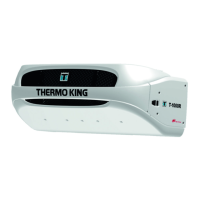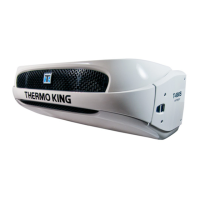Unit Description
20
Defrost
Frost will gradually build up on the evaporator coils as a result
of normal operation. Periodically this frost must be melted to
prevent a loss of cooling and airflow.
Defrost is accomplished by passing hot refrigerant gas through
the evaporator coil, thus melting the frost (or ice). Melted frost
drains out of the unit onto the ground through the drain tubes.
The defrost damper closes during defrost to prevent warm air
from entering the cargo area. The optional electric heater strips
are also energized in defrost during electric standby operation.
Defrost can be initiated at any time the evaporator coil
temperature is below 42 F (5.5 C).
There are two methods of defrost initiation:
TSR/TSR-3 Microprocessor Controller
The Microprocessor Controller is programmed to
automatically initiate timed and forced defrost cycles. The
TSR/TSR-3 uses temperature sensors to determine if forced
defrost is required.
Manual Defrost
Manual Defrost allows the operator to initiate a defrost cycle
by pressing the Defrost key. See “Initiating a Manual Defrost
Cycle.”
DAS - Data Acquisition System
NOTE: (Optional )(Not available on T-560R)
The DAS (Data Acquisition System) monitors and records the
temperatures of (up to) six additional sensors. The sensors are
independent from the microprocessor controller and are
normally located in the truck box to monitor load temperatures.
DAS data can be downloaded through a serial port to an IBM®
PC compatible computer. WinTrac™ 4.8 (or higher) software
is used to view and analyze the data. Brief reports can be
printed on a microprinter connected to the serial port.
Electric Standby
NOTE: (Model 50 Units Only)

